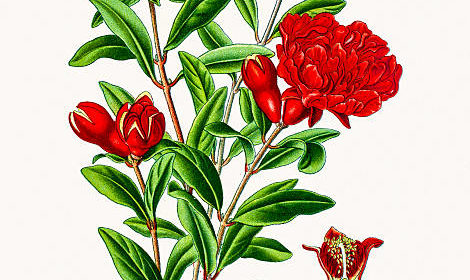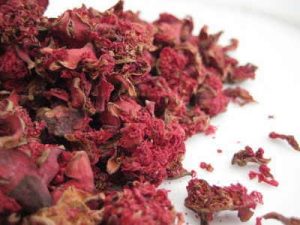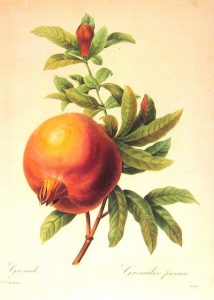
Pomegranate Flowers – Punica granatum – Traditional Herbal Uses
Pomegranate Flowers (Punica granatum) can have a beneficial effect for overall general health. The tree will bloom abundantly although little blossom will set fruit in cooler climes and blossom fall is common, however the flowers are generally sun dried and then the blossoms can used to make a herbal tea. A tea made from the flowers is generally believed to be beneficial for specific cardiac health, to reduce the symptoms of diabetes and good for general health.
The flowers have astringent effects and can be used to help prevent acne. A toner or face pack made using the flowers is excellent for skin health.
Spots on the skin can be treated using the extract obtained from pomegranate flowers (either in tincture or infused form)
An infusion made using the flowers helps to control diarrhoea and drinking the tea in small doses lessens the effect of diarrhoea
Dried pomegranate flower (when powdered) can be used in the preparation of a herbal tooth powder. The flowers can treat gingivitis and are good for overall oral health.
Used to help relieve the discomfort of migraines and minor headaches.
In other cultures it is known by a variety of names such as Granada or Granado, Dulim, Dadima, Granatapfel, Melegrano or Pomo Granato.
History and Mythology of Pomegranate:-
The tree is native of the Middle East stretching to the Himalayas in northern India and has been cultivated since ancient times throughout the Mediterranean region of Asia, Africa and Europe.
The fruit was used in many ways as it is today and was featured in Egyptian mythology and art and was prized in the ancient world.
It was known to central and southern India where it was brought from the Middle East about the first century A.D. and was reportedly growing in Indonesia in 1416. It has been widely cultivated throughout India and drier parts of southeast Asia, Malaysia, the East Indies and tropical Africa since. The most important growing regions today are Egypt, China, Afghanistan, Pakistan, Bangladesh, Iran, Iraq, India, Burma and Saudi Arabia. There are some commercial orchards in Israel on the coastal plain and in the Jordan Valley.
It is rather commonly planted and has become naturalized in Bermuda where it was first recorded in 1621, but only occasionally seen in the Bahamas, West Indies and warm areas of South and Central America. Many people grow it at cool altitudes in the interior of Honduras. In Mexico it is frequently planted, and it is sometimes found in gardens in Hawaii. The tree was introduced to California by Spanish settlers in 1769. It is grown for its fruit mostly in the dry zones of that state and Arizona. In California, commercial pomegranate cultivation is concentrated in Tulare, Fresno and Kern counties, with small farms in Imperial and Riverside counties.
Images of the fruit are used to represent fertility, which seems to have its origins everywhere. We see it in the Middle East and India. The fruit was cultivated in Egypt before the time of Moses. It was found in the Indus valley so early that there is a word in Sanskrit for pomegranate. Indian royalty began their banquets with pomegranate, grape, and jujube. Arab caravans probably spread its use.
The pomegranate is significant in Jewish custom. Tradition holds that a pomegranate has 613 seeds to represent the 613 commandments in the Torah. The design of the pomegranate was woven into the high priest’s robes, and brass representations were part of the Temple’s pillars. It is mentioned six times in the Song of Solomon. We see it again in ancient Greece and Rome. In the verses of the Odyssey, Homer mentions it as part of the gardens of Alcinous (probably in Sicily). The Romans imported their pomegranates from African Libya, and Pliny the Elder gave instructions for its storage. It appears in China during the Han and Sung dynasties.
The derivation of the word pomegranate comes from the Middle French pome garnete (seeded apple), but Europeans were slow to adopt the pomegranate. It was probably introduced from Sicily, however Europeans, then under Norman influence, distrusted fruits and vegetables, preferring a meat-based diet. It is mentioned in the 14th century Ménagier de Paris which offered some recipes, and it was known in England in Elizabethan times being mentioned in Shakespeare’s Romeo and Juliet. The enthusiasm for pomegranate as a food was limited, but it was widely used as a decoration.
The Spanish Conquistadores brought the pomegranate to America. Jesuit missionaries carried it north to their missions in California. They were found growing wild in Georgia in 1772 .


